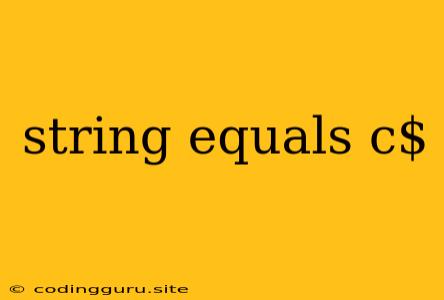String Equality in C#: A Comprehensive Guide
When working with strings in C#, you often need to compare them to see if they are equal. This is a fundamental operation that comes up frequently in various scenarios, such as:
- Validating user input: Ensuring a user enters the correct information, like a username or password.
- Searching for data: Finding specific items within a list or database.
- Conditional logic: Executing different code blocks based on whether two strings are the same.
While it might seem straightforward, C# provides multiple ways to compare strings, each with its own nuances. Understanding these differences is crucial for writing accurate and efficient code.
The Pitfalls of == for String Comparison
Many new C# programmers instinctively reach for the == operator to check if two strings are equal. However, == in C# performs reference equality for objects. This means it checks if the two variables point to the same location in memory.
Example:
string str1 = "Hello";
string str2 = "Hello";
bool areEqual = str1 == str2; // areEqual will be true
In this case, str1 and str2 both refer to the same string object in the string pool, so == returns true. However, this behavior is not guaranteed in all cases:
string str3 = new string("Hello");
string str4 = new string("Hello");
bool areEqual = str3 == str4; // areEqual will be false
Here, str3 and str4 are created using the new keyword, resulting in separate string objects, even though they have the same content. == will return false because the objects are not stored in the same memory location.
The Reliable Equals() Method
To ensure accurate string comparison based on content, you should use the Equals() method.
string str1 = "Hello";
string str2 = "Hello";
string str3 = new string("Hello");
string str4 = new string("Hello");
bool areEqual1 = str1.Equals(str2); // areEqual1 will be true
bool areEqual2 = str3.Equals(str4); // areEqual2 will be true
The Equals() method, inherited from the object class, compares the content of the strings, regardless of whether they are stored in the same memory location. This ensures consistent and reliable comparisons.
Case Sensitivity
By default, Equals() performs case-sensitive comparisons. This means that "Hello" and "hello" will be considered different.
string str1 = "Hello";
string str2 = "hello";
bool areEqual = str1.Equals(str2); // areEqual will be false
To perform case-insensitive comparisons, you can use the StringComparison.OrdinalIgnoreCase enum value as an argument:
string str1 = "Hello";
string str2 = "hello";
bool areEqual = str1.Equals(str2, StringComparison.OrdinalIgnoreCase); // areEqual will be true
Other Useful Methods
C# provides several additional methods for comparing strings, each serving a specific purpose:
String.Compare(): Returns an integer indicating the lexical order of two strings. Useful for sorting.String.CompareTo(): Similar toString.Compare(), but returns an integer value based on the string's alphabetical order.String.StartsWith(): Checks if a string starts with a specific substring.String.EndsWith(): Checks if a string ends with a specific substring.
Example:
string str = "Hello, World!";
bool startsWithHello = str.StartsWith("Hello"); // startsWithHello will be true
bool endsWithWorld = str.EndsWith("World!"); // endsWithWorld will be true
Best Practices for String Comparison
- Use
Equals()for content comparison. This is the most reliable way to check if two strings have the same content. - Consider case sensitivity. Use
StringComparison.OrdinalIgnoreCaseif case-insensitive comparisons are required. - Use appropriate methods for specific tasks.
String.Compare()is useful for sorting, whileString.StartsWith()andString.EndsWith()are helpful for substring checks.
Conclusion
Understanding the various ways to compare strings in C# is essential for writing accurate and reliable code. While == might seem like the obvious choice, it's important to remember that it only checks for reference equality, which can lead to unexpected behavior.
Always use the Equals() method for content comparison and consider the case sensitivity implications. By choosing the appropriate method for the task at hand, you can ensure consistent and accurate results.
